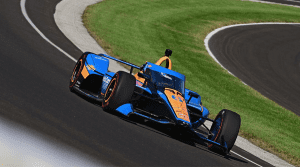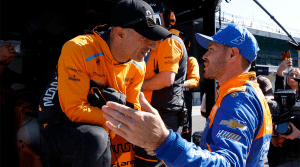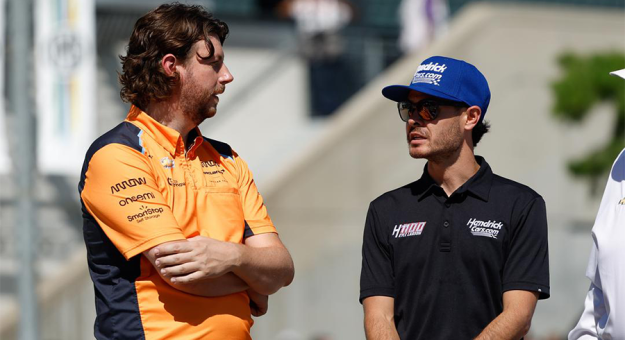A group of adult hockey players was gathered in the lobby of the Carmel Ice Stadium situated about 15 miles north of Indianapolis when an unusual sight grabbed their attention.
It was odd enough to see a Kei truck (also known as a Japanese mini truck) wheel into the parking lot, but when the driver emerged from the right side of the cab everyone’s interest was piqued. Hopping out of his vehicle, Gavin Ward gathered up his goalie gear and proceeded to the entrance.
Each of the participants in this hockey group had a story to tell, but few were as interesting as Ward’s.
Raised in Toronto, Gavin first volunteered on a Formula Ford racing team before taking the bold step to continue his education in England at Oxford Brookes University. His plan was to study automotive engineering and somehow forge a career in racing.
Many harbor dreams of finding a niche in the world of Formula 1 but in Ward’s case it all came true. He progressed through the ranks with Red Bull Racing and in time was a key player in 50 wins, and four driver’s and constructor’s championships. After a dozen years in Europe, Ward realized he needed a change of scenery.
He accepted a position with Team Penske and won back-to-back Indianapolis 500s with Will Power and Simon Pagenaud. In 2019, he was the lead engineer for NTT IndyCar Series champion Joseph Newgarden.
After his successful stint at Penske, Ward joined Arrow McLaren and relocated to Indianapolis. In relatively short order he progressed to the role of Team Principal.
Despite an already full plate, Ward was presented with an interesting proposition from McLaren CEO Zak Brown.

“Zak first came to me and asked about doing a four-car program, and he asked if it would stretch us too thin to run an extra car for the 500,” Ward explained. “I said that if we planned ahead, we would be fine. I thought it could make us a stronger team.”
It was here that Gavin proved to be prescient. “I said to Zak, ‘if you told me I could have someone like Kyle Larson then that’s an easy decision,’” Ward related.
At the time, Ward had no idea such an arrangement was possible. But it seems the perfect pairing for Ward, who can often be seen sporting a Rico Abreu T-shirt. Ward isn’t just a curious spectator. He has genuine regard for short-track racing.
“At the point that I moved to North Carolina to work with Penske I didn’t have any kids, and my wife didn’t move over until eight months later,” he recalled. “So I was looking for things to do. I decided to go to East Lincoln Speedway one Saturday on my own. That was the first time I watched proper dirt-track racing, and I thought this is amazing. I even wondered how much it cost to buy one of these cars.
“There were a lot of guys I worked with at Penske and a lot of guys here who came up through dirt-track racing and are passionate about it. Last year I went to the Chili Bowl, which I thought was super neat.”
As an engineer there is little doubt that Ward is analytical, understands systems and is data and science driven. Still, he firmly believes Larson has the requisite skills and racing background to succeed at Indianapolis.
“If you look at the best racers in the world right now, I would put Kyle in that group and I would put Max Verstappen and Lando Norris in that group,” Ward explained. “They are among this new wave of drivers. I’m a bit of a sports science geek and there is a lot out there now on skill acquisition. The question is how do you train a better athlete? So how do you train a better race car driver?
“There is the old-school view, which has now become quite antiquated, that it is about repetition, fixed drills and doing the same things over and over and just getting better,” Ward continued. “In soccer, or what everyone else calls football, it has been proven that this doesn’t really work. Here you have kids living in the favela’s outside of Sao Paulo in Brazil who beat the heck out of guys who spent millions on their sports development in Europe learning to play.
“You see kids who grew up in the USSR beating the heck out of these comparatively rich Western countries because they just play mini games. And in both cases these kids play lots of different sports, and they don’t have coaches and all this money spent on them.”
So, what does this have to do with Kyle Larson? Plenty if you ask Ward.

“I think the same thing is happening in racing and you see it with Larson,” he said. “Here is a guy who races everything and that is the way it used to be. Rick Mears did all kinds of racing but that went away with fears of them getting hurt and things like commercial commitments and conflicting schedules.”
Ward realizes because of Larson’s unique situation he has a great deal of control over his racing life. He can race sprint cars, midgets, or jump in a late model. Ward suggests that in cases where drivers have less of an opportunity to emulate what Larson does, E-racing may be the next best option.
“Max Verstappen is adamant that E-racing makes him a better race driver,” Ward said. “There he drives 24-hour sports car races, he drives dirt races and he will do anything. E-racing gives drivers wider experiences that you don’t get so much anymore.”
Ward said his theory is based on contemporary science.
“This is where sports science is going,” he said. “It is called the ecological approach to skill acquisition. It is really about how athletes learn through natural self-organization, through mini games, differential learning, or by changing the constraints of the game. It is fun and competitive.
“In Formula 1, you have millions of dollars spent on simulator development and big motion platforms have become a thing. But an argument can be made that a person sitting static in front of a computer racing on the internet may get more actual racing knowledge.”
In Ward’s opinion, Larson’s experience will help him be more successful driving an Indy car.
“Kyle gets all that practice racing every week,” Ward said, “and I think there is something to be said for that and a scientific basis for why that is important.”
Larson ran his first laps in an Indy car at Indianapolis Motor Speedway in October.
“What we have done so far is just running on your own, which frankly is not the deal at the speedway,” Ward said. “The deal is running in traffic and dealing with dirty air. But again, this is someone who has done a lot of figuring out in different kinds of racing. All you need to look at is what an average sprint car race is like.”
Thus far the report card is good.
“Right away he is super calm,” Ward observed. “One thing I noticed right away was that Kyle wasn’t fazed by the speed. I also liked that he picked up right away the importance of pit lane procedures. If you look at a typical Indy 500 somewhere between a quarter and a third of people ruin their month of May in pit lane. So, he has a race sense that is really pragmatic.”
Ward knows that somehow Larson is different from other drivers, but the question that drives him is how and why?
“I think there is a level of feel,” he said. “How do you as a driver take a race car to the absolute limit. Every driver is quite different. They are using their vestibular system to feel yaw motion, feel the steering wheel, weight, and all the cues a driver uses to know how their car is behaving and when it nears the limit. That skill transfers maximally from any discipline.”
Ward appreciates that Larson is constantly competing. However, just as important as the sheer volume of work is the fact that he spends time in vastly different race cars and in a wide range of environments and conditions. Whether he is in a midget on a bullring or rocketing around a superspeedway in a stock car, Larson is constantly learning.
Ward notes these same principles come into play as Larson transitions to an Indy car and prepares for the Indianapolis 500.
There will be a learning curve as he understands the attitude of the car in racing conditions and gains comfort with the range of in-car adjustments at his disposal. How quickly Larson masters these matters falls squarely on his shoulders.
“There is also a lot about how you build up to the month of May,” Ward says, “When I came over from F-1 to IndyCar one of the funniest things I thought was how preparing for the Indianapolis 500 is a lot like preparing for Monaco. At face value there are no two races more different than Monaco and the Indy 500. Yet, to me they were the most similar in a lot of ways because they were the big high-pressure events, they were longer and you have all of this external pressure.
“But the key thing for the driver is confidence,” Ward added. “At the 500 you have to build up to it step by step. It is about not spooking the driver, not having accidents, and it is about building your knowledge bank for different conditions. Say it is race day and it is hot and windy, now it comes down to remembering that in those kinds of conditions we pinned the nose in turn three. You have to build that knowledge bank.
“It isn’t that Kyle has to memorize all of that he just needs to work with his engineer and crew to build that. It is how we go through the month to tick off the boxes and get him confident to qualify, confident to race and be prepared. That is a really interesting journey.”
Confidence is also an important matter for Ward and his Arrow McLaren team. Larson’s appearance in the Indianapolis 500 is important to him and to Indy car racing. In many ways Larson is representing a legion of American short-track, open-wheel participants and fans.
Are they hoping Larson makes a statement in May? You bet they do.
The good news is that Larson has the right guy in his corner.
“I think he wants to be immersed in it,” Ward said. “He obviously has a lot going on, but it is a big deal and he just doesn’t want to show up. I think we can give him a competitive race car.”
The entire Arrow McLaren team understands there is a lot on the line.
“It is super important and I think the relationship with Hendrick (Motorsports) has been awesome,” Ward said. “To bring two of the greatest racing organizations in the world together is pretty cool. To have Mr. H (Rick Hendrick) as interested and excited about the program as he his has added an extra buzz for sure.”
With so much riding on Larson’s appearance in the Indianapolis 500 will he climb in a sprint car during the month of May? His IndyCar team has no plans of standing in his way.
“We’re not going to change Kyle Larson from being Kyle Larson,” Ward said. “There is a level of risk in everything.”
That statement alone will make Ward a hero to many short-track fans.
